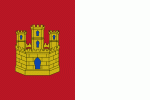Castile-La Mancha (Castilla-La Mancha)
 |
 |
The region largely occupies the southern half of the Iberian Peninsula's Inner Plateau, including large parts of the catchment areas of the Tagus, the Guadiana and the Júcar, while the northeastern relief comprises the Sistema Ibérico mountain massif.
It is bordered by Castile and León, Madrid, Aragon, Valencia, Murcia, Andalusia, and Extremadura. It is one of the most sparsely populated of Spain's regions. Albacete, Guadalajara, Toledo, Talavera de la Reina and Ciudad Real concentrate the largest urban areas in the region.
Castilla–La Mancha is located in the middle of the Iberian peninsula, occupying the greater part of the Submeseta Sur, the vast plain composing the southern part of the Meseta Central. The Submeseta Sur (and the autonomous community) is separated from the Submeseta Norte (and the community of Castilla y León) by the mountain range known as the Sistema Central. Despite this, the region has no shortage of mountain landscapes: the southern slopes of the aforementioned Sistema Central in the north, the Sistema Ibérico in the northeast, and the Sierra Morena and Montes de Toledo in the south.
Castilla–La Mancha is the third largest of Spain's autonomous regions, with a surface area of 79463 km2, representing 15.7 percent of Spain's national territory.
The regional urban structure is polycentric, with no dominant central city. Insofar the largest municipality (Albacete) is located in the peripheral southeast, Madrid (outside the region), exerts influence over the extension of the so-called Corredor del Henares into the province of Guadalajara (including the provincial capital) as well as the north of the province of Toledo. The rest of urban centres lie on the central plains (with for example, the presence of intermediate agro-cities in La Mancha), contrasting with the sparsedly populated mountains and other peripheral areas.
Map - Castile-La Mancha (Castilla-La Mancha)
Map
Country - Spain
 |
 |
| Flag of Spain | |
Anatomically modern humans first arrived in the Iberian Peninsula around 42,000 years ago. The ancient Iberian and Celtic tribes, along with other pre-Roman peoples, dwelled the territory maintaining contacts with foreign Mediterranean cultures. The Roman conquest and colonization of the peninsula (Hispania) ensued, bringing the Romanization of the population. Receding of Western Roman imperial authority ushered in the migration of different non-Roman peoples from Central and Northern Europe with the Visigoths as the dominant power in the peninsula by the fifth century. In the early eighth century, most of the peninsula was conquered by the Umayyad Caliphate, and during early Islamic rule, Al-Andalus became a dominant peninsular power centered in Córdoba. Several Christian kingdoms emerged in Northern Iberia, chief among them León, Castile, Aragon, Portugal, and Navarre made an intermittent southward military expansion, known as Reconquista, repelling the Islamic rule in Iberia, which culminated with the Christian seizure of the Emirate of Granada in 1492. Jews and Muslims were forced to choose between conversion to Catholicism or expulsion, and eventually the converts were expelled through different royal decrees.
Currency / Language
| ISO | Currency | Symbol | Significant figures |
|---|---|---|---|
| EUR | Euro | € | 2 |
| ISO | Language |
|---|---|
| EU | Basque language |
| CA | Catalan language |
| GL | Galician language |
| OC | Occitan language |
| ES | Spanish language |




















